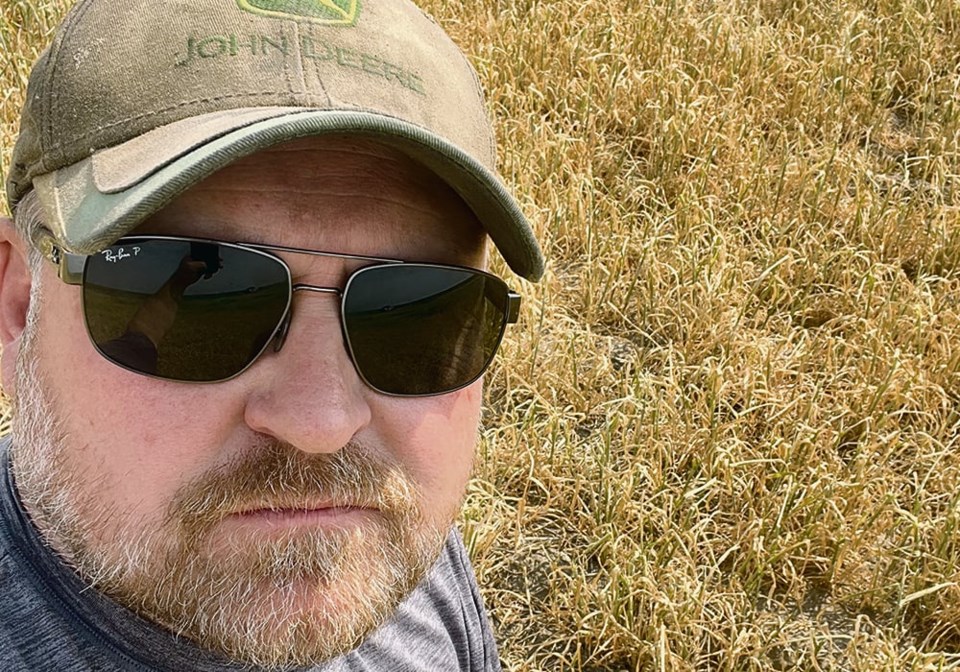GOLDEN PRAIRIE, Sask. — Seven is often considered a lucky number but not for Tyson Jacksteit.
That’s how many consecutive years of drought his family has now gone through on their west-central Saskatchewan farm near Golden Prairie.
The last good crop was in 2016, he said, with the rain from that year carrying them through the next. But since then it’s just been “a downhill slide of drought.”
“We’re in survival mode,” he said last week.
Jacksteit farms about 7,000 acres with his brother and also runs about 200 cows with his son. Last year, they sold 50 cows because of the lack of feed and may have to sell more.
He said his 80-year-old dad has never seen it so bad. There have been dry periods, of course, but never such a long streak.
“We’re going to scratch to get seed (this year),” said Jacksteit, who has been farming since 1995 and grows wheat, lentils, durum, barley and mustard.
Fall rye has historically been a good crop in the area but he said it’s been so dry it isn’t an option. Even if it had been planted, grasshoppers would have wiped it out the last two years.
At this point, rain is welcome simply to help conditions next year.
Drought is the story this year throughout west-central Saskatchewan and a huge part of east-central and southeast Alberta.
Rural municipalities and counties are declaring agricultural disasters to get government attention. Jacksteit is a councillor for his local RM and said they expected to declare a disaster at a meeting this week.
He said he isn’t just concerned for himself but for others, too.
“This is going to lead into young people leaving the farm because our programs are not sufficient enough,” he said.
“The majority of the crops are not even salvageable for feed.”
Low crop yields year after year send insurance coverage levels down and premiums up, he said, although payments have helped limit losses. And, Jacksteit said, the way AgriStability is set up, he won’t qualify because it is based on average margins earned over the past five years.
“When you have had nothing for seven (years) there’s no way of ever qualifying for AgStability because zero is zero,” he said.
Saskatchewan agriculture minister David Marit said July 7 he is looking at options the province has used before, such as allowing very poor crops to be cut for feed.
But he said grain farmers will have to make do with crop insurance and AgriStability.
“The programs are in place,” Marit said, even while acknowledging the magnitude of the problem.
Jacksteit has mixed feelings about the change to individual crop insurance premiums this year. The program is better because commodity prices are higher, but also worse because the experience discount is gone, he said.
For many, that would substantially lessen the premiums, he said.
He also noted that crop insurance guarantees are higher on the eastern side of the province.
“I realize we don’t get the rain that they do. We can’t grow the crops, but our costs are the same,” he said.
Jacksteit said he is asking for improvements, not a handout.
“Our guarantees have to be at least at the break-even point. If you want farmers on the land, they have to be able to at least break even,” he said, adding that he knows seven years of drought isn’t normal.
Input costs, inflation and interest rates are all putting more pressure on the bottom line, too.
Crop insurance adjusters have been out to look at crops in his area and Jacksteit said if a decision to bale crops expected to yield less than 10 bushels per acre isn’t made soon, they will only be “glorified straw.”
That will also affect his, and others’, decision about what to do with the cow herd.
Provincial crop reports reflect the worsening soil moisture conditions.
In Saskatchewan, at the end of June, 57 percent of cropland topsoil moisture is rated short or very short, with the lowest levels in the southwest and west-central regions.
On hay and pasture, 63 percent are short to very short.
Alberta’s crop report showed subsurface moisture at 54 percent poor to fair. In Manitoba, moisture conditions are optimal to dry in most of the province with wet conditions in some parts of the southwest, northwest and Interlake.
Meanwhile, the Canadian Crop Hail Association reported more than 1,000 claims of minor to severe damage in June in all three provinces.
“We’re seeing a big variety of conditions in all provinces of Western Canada,” said CCHA president Scott McQueen. “Some areas are experiencing severe drought while others have normal to excellent moisture.”
For Jacksteit, his wife and four children, 2023 is another year of hoping the next will be better. Talk in the coffee shop centres on those who are considering getting jobs, which won’t cover the losses they’re facing this year, and those who might quit.
“The thought has crossed my mind, why are we doing this?” he said.
But with two sons, the fourth generation, who love the farm, he said they will most likely fight on.
“It’s hard,” said Jacksteit. “It’s almost like you’re letting your previous family down by leaving.”




